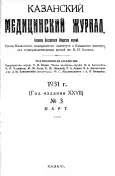Case of perinatal retroperitoneal cyst
- Authors: Nizner V.I.1
-
Affiliations:
- Kazan Medical Institute
- Issue: Vol 27, No 3 (1931)
- Pages: 247-252
- Section: Clinical medicine
- URL: https://journals.rcsi.science/kazanmedj/article/view/106621
- DOI: https://doi.org/10.17816/kazmj106621
- ID: 106621
Cite item
Full Text
Abstract
Amniotic cysts are among the very rare pathological formations. They are of great interest not only because of their rarity, but also because of the difficulty of recognizing and diagnosing them, as well as in relation to their pathogenesis. Not all authors are unanimous on the question of which cysts are considered perinephrine. Regieg, for example, considers as true pararenal cysts only those that have developed in the area of the pararenal fiber and have no other relation to the kidney other than contact with it. Other authors, and the majority of them, do not exclude from the group of pararenal cysts also those cyst-like formations that have closer contact with the kidney, have communication or fusion with the pelvis, with the kidney, or are located in its fibrous capsule. From the group of amniotic cysts, cysts of parasitic origin—echinococcus, as well as hydro and pionephrosis are excluded. It is now customary to divide ecolopened cysts into the following groups according to Küster: group 1—traumatic, it is more correct to call them according to Fedorov, Lirens'y—fibrinous; group 2—epithelial cysts; 3 gr.—lymphatic cysts; 4 gr.—cysts developing from the embryonic remains of the Bolf bodies and, finally, 5 gr.—dermoid cysts.
Keywords
Full Text
##article.viewOnOriginalSite##About the authors
V. I. Nizner
Kazan Medical Institute
Author for correspondence.
Email: info@eco-vector.com
Hospital Surgical Clinic
Russian Federation, KazanReferences
Supplementary files





